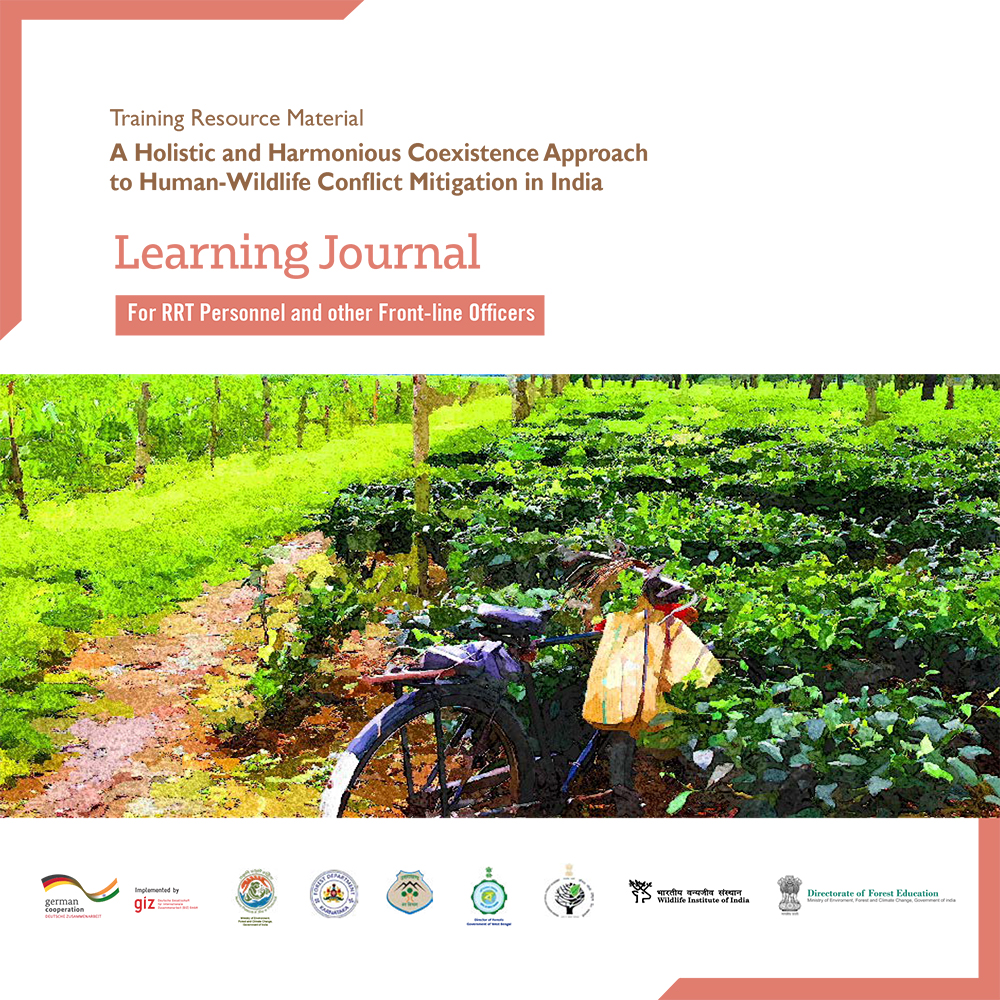Competencies have been described in the National Training Policy (2012) of India to encompass knowledge, skills and behaviour, which are required in an individual for effectively performing the functions of a post. Under the Indo-German Project on Human-Wildlife Conflict Mitigation in India, an attempt has been made to define the professional competencies required for the personnel engaged in human-wildlife conflict mitigation. This competency framework was used to conduct Training Needs Assessment, subsequently guiding the way to develop a curriculum and elaborate training materials for trainings on human-wildlife conflict mitigation in India. The competency framework can be downloaded here
Following the first results of the competency framework, the development of curriculum took a systems approach, using participatory methods with three phases and seven process steps.
The curriculum is modularised, with modules being delivered using different training methods over required time periods. The modularised structure provides flexibility to adapt the contents, methods and durations of different topics on the basis of the training needs of the participants. Learning outcomes have been formulated for different groups of participants, and so the modules can be used in any combination and over different durations, for specific purposes and to fit specific training schedules.
A unique feature of the curriculum is that it focuses on HWC using the "thematic triangle" of driver-prevention– damage reduction.
There are some common modules for all key stakeholders. These cover common issues and the basics of HWC. Specialized modules have been developed to deepen the understanding and skills of different training groups in their respective fields.
The curriculum uses a mix of conceptual and hands-on training sessions, in almost equal proportions, to facilitate the application of conceptual knowledge and skills to field conditions and the appreciation and understanding of the issue of HWC in a larger development context by the participants.
| SN | RRT | Trainings | Time/ days |
|---|---|---|---|
| 1 | Division and Range RRT + Community PRTs +other agencies | Monitoring and managing Habitat related drivers and pressures of HWC | 1 day (Basic) 3 days (Advanced for hotspots of invasive species/ forest fire/ waste management) |
| 2 | Division + Range | Fieldcraft on monitoring, tracking and rescue operation of key wildlife species-in-conflict in the landscape | 3 |
| 3 | Division + Range RRT | Development, maintenance and adaptation of effective and wildlife-friendly HWC mitigation measures (Advanced) | 1 |
| 4 | Division + Range | Use and maintenance of HWC mitigation equipment, basics of Early Warning and Rapid Response System (EWRR) !^ | 1 |
| 5 | Division | Use and maintenance of Unmanned Aerial vehicles (UAVs)/Drones | 4 |
| 6 | Division + Range | Snake handling and rescue | 1 |
| 7 | Division + Range RRT | Use of digital tools for HWC Mitigation | 0.5 (basic)/ 2 (Advanced) |
| 8 | Division | Capture, handling and post-capture management of (key wildlife species-in-conflict in the landscape) * | 3 |
| 9 | Division + Range | Occupational Health and Safety, taking a One Health approach (OH), including basics of first aid for animals | 1 |
| 10 | Division RRTs + Range RRTs + other agencies |
Implementing a Common Emergency Response Plan for HWC-related emergencies in the district (simulation) | 3 |
| 11 | Division, Range RRT, other staff of SFDs | Leadership and communication: Taking an inclusive and participatory approach to HWC Mitigation | 1 |
This "Trainer's ToolKit" is useful for the faculty members, trainers and other experts delivering courses/ expeditions on "Coastal and marine biodiversity and protected area management" for the field-level managers.
.jpg)
Trainer’s Guide: A Participatory Approach to Planning and Implementing Trainings on Human-Wildlife Conflict Mitigation in India (2023)
This trainer’s Guide facilitates the trainers and faculty members of trainings institutions of forest-wildlife, agriculture-veterinary, public health, media, rural development and Panchayati Raj and other relevant sectors in planning, implementing and updating the trainings on a holistic approach to HWC mitigation effectively through enhanced learning of the participants.
The Trainer’s Guide contains notes that provide details on the competency framework, and competencies-based training curriculum for key actors and stakeholders, provides sample training plans to implement the curriculum, and a detailed section to facilitate the use of participatory training methods.
The guide also serves as a compendium of selected participatory training methods, which are innovative, have been tested for their effectiveness, and are easy to be applied. The training methods can be customised to suit the learning objectives, audience, time availability, resource availability and other factors. It is also possible to include new case studies, relevant reading material or training activities as they become available. This guide provides general notes on planning, implementing and evaluating participatory trainings on ‘A Holistic Approach to HWC Mitigation in India’, and ‘Taking a One Health Approach to HWC Mitigation in India’ and specific tools for target-group-specific trainings for participants from, agriculture, media, community-institutions and field response teams. To access the Trainer’s Guide, Click here

Content modules, or Training Resource Material contain modules that will facilitate both trainers and participants in receiving background information on the training topics, apart from a field manual that will specifically be used by front-line staff.
To access the Training Resource Material, Click here

Learning Journal, To facilitate the participant’s learning during and after the training, a learning journal is designed to help them capture anything that is of any significance or value to them and may help in enhancing their understanding of the HWC Mitigation and One Health concept, in general, and its application in the field, in particular. It is a place for participants to take notes on their observations on people, animals, systems, environment, and processes during the training.
To access the Learning Journal for forest officers, Click here
© 2014 IGBP. All Rights Reserved.
Site By: Virtualpages
